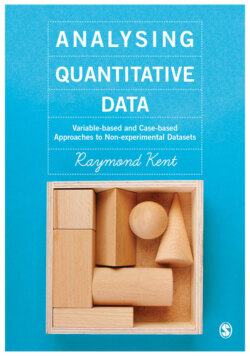Читать книгу Analysing Quantitative Data - Raymond A Kent - Страница 20
На сайте Литреса книга снята с продажи.
Key points and wider issues
ОглавлениеValues are what researchers actually record as a result of the process of assessing properties of cases. However, they may arise either as variables or as set memberships. The values of variables assess cases relative to one another; sets define memberships in absolute terms according to generally agreed external standards or based on a combination of theoretical knowledge and practical experience of cases. The values recorded for variables arise from one or more of the measurement activities of classifying, ordering, ranking, counting or calibrating the characteristics of cases. These activities result in variables that may be binary, nominal, ordered category, ranked, discrete metric or continuous metric. These types of variable can themselves be seen as a variable having ordered category characteristics of increasing complexity from binary up to continuous metric.
Sometimes the distinction between the different types of measure is blurred, or difficult to make or open to interpretation. Thus the numerical totals derived from summated rating scales should, strictly speaking, be used only to create ordered categories from high to low. The totals only indicate relative positions, so that while 15 is ‘higher’ than 12, by how much is unclear because there are no ‘units’ of measurement. There is no metric for measuring people’s attitudes, opinions or beliefs. In practice, however, researchers commonly treat the results, particularly of Likert scales, as if they are metric and will calculate average scores and use the results in statistical procedures that require metric data. Such a practice is making the assumption of equivalence of distance between recorded values, so that the difference, for example between ‘Strongly agree’ and ‘Agree’, is the ‘same as’ the distance between ‘Agree’ and ‘Neither’ and between ‘Disagree’ and ‘Strongly disagree’. This may be a reasonable assumption for the standard Likert scale and little error may result from acting as if the resulting scale is metric, but for other kinds of scale the assumption may be unwarranted or at least questionable.
The assessment of set membership may result in crisp or fuzzy sets. Crisp sets are the same as binary variables and record cases as either members or non-members of a set. Fuzzy sets allow degrees of membership and combine binary with metric characteristics with membership values between [1] and [0] with [0.5] as the crossover point.
